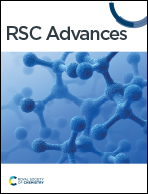Synthesis and application of novel N, Si-carbon dots for the ratiometric fluorescent monitoring of the antibiotic balofloxacin in tablets and serum
Abstract
A ratiometric fluorescent probe with blue-emission fluorescence based on N, Si-doped carbon dots (N, Si-CDs) for the detection of balofloxacin (BLFX) was synthesized by simple one-pot hydrothermal carbonization using methotrexate and 3-aminopropyltriethoxysilane (APTES) as carbon materials. The obtained N, Si-CDs showed dual-emission band fluorescence characterization at 374 nm and 466 nm. Furthermore, the synthesized N, Si-CD probe exhibited evidence of ratiometric fluorescence emission characteristics (F466/F374) toward BLFX along with a decrease in fluorescence intensity at 374 nm and an increase in fluorescence intensity at 466 nm. Based on this probe, a highly sensitive and fast detection method for the analysis of BLFX has been established with a linear range of 1–60 μM and a low detection limit of 0.1874 μM, as well as a rapid response time of 5.0 s. The developed assay has also been successfully applied for the detection of BLFX in tablets and rat serum.



 Please wait while we load your content...
Please wait while we load your content...